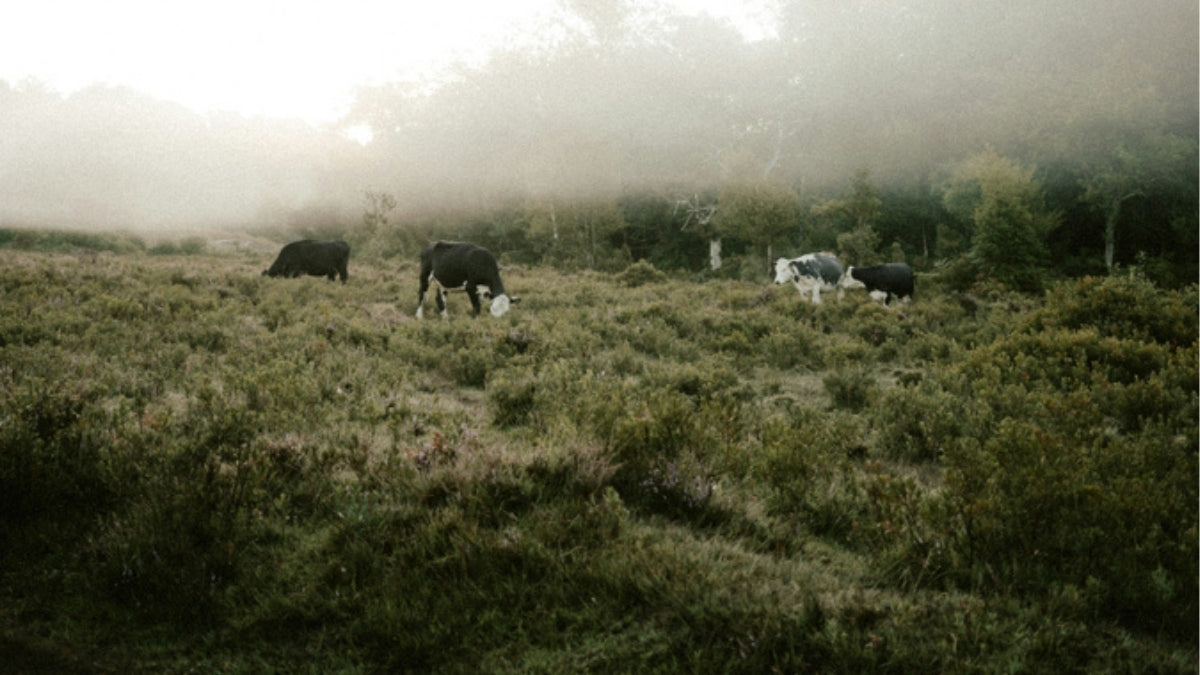
Why Grass-Fed Tallow Matters: The Key to Healthier Skin, Happier Cows, and a Thriving Planet
|
|
Time to read 5 min
|
|
Time to read 5 min
At Field & Forage, our tallow skincare company, we deeply believe that what goes into the cows that provide our grass-fed tallow matters as much as the care we put into crafting our products.
Grass-fed isn’t just a buzzword—it’s the cornerstone of a better future for your skin, the cows, and the planet as a whole.
Let’s dive into why.
TABLE OF CONTENTS
When cows are fed their natural diet of grass, their fat—and therefore the tallow produced from it—is richer in essential fatty acids, vitamins, and nutrients.
These components of grass-fed tallow nourish your skin, delivering :
But grass-fed tallow matters for much more than just skincare.
Grass-fed cattle live healthier, more natural lives.
Grazing on pasture allows cows to express their innate behaviors, avoiding the stress and sickness associated with crowded feedlots.
Their diets remain aligned with their biology, resulting in healthier animals and, by extension, healthier grass-fed tallow skincare for us.
Contrary to what you might have heard, cows and other grazing ruminants are not the villains in the climate story. In fact, they hold the key to restoring balance in our ecosystems and mitigating climate change. Here’s how:
Soil Building and Carbon Sequestration Managed grazing practices—where cattle are rotated to mimic the natural movement of herbivores like bison—build soil health. When cows graze, their tugging on grass stimulates new growth, while their manure and hoof action enhance the soil microbiome. Even the act of eating grass causes roots to die back, adding organic matter to the soil. This porosity increases the soil’s ability to store carbon, effectively pulling CO2 out of the atmosphere and locking it in the ground.
Water Cycle Restoration Healthy soil is like a sponge. For every 1% increase in organic matter, the soil can hold up to 25,000 gallons of water per acre. This natural water storage mitigates both drought and floods by retaining water during dry spells and absorbing excess during heavy rains. Grass-fed systems support these hydrological cycles, unlike conventional feedlot systems that contribute to water pollution and waste.
Topsoil Preservation Soil takes 500 to 1,000 years to build just one inch, yet we’re losing tons of topsoil annually to erosion—an alarming trend that threatens global food security and ecosystem health. Grazing cattle help anchor the soil with perennial plants, preventing erosion and sustaining the biodiversity essential to life on Earth.
No Tilling Needed Unlike row cropping for grains, which requires tilling and disrupts the soil’s structure, grazing cattle work in harmony with the land. Tilling releases stored carbon, destroys soil biology, and exacerbates erosion. Grass-fed systems avoid this entirely.
Grass-fed cattle are often part of regenerative agricultural systems that prioritize biodiversity. Grazing pastures include a mix of native plants including perennials grasses, and flowering plants essential to pollinators, insects, birds, and mammals.
At our own farm, we practice silvopasture—grazing cattle within wooded areas—to stack ecological functions and mimic thriving natural ecosystems. This approach enhances productivity while supporting local wildlife.
A common argument against beef production is its water usage, but let’s clarify: 95% of the water used in pastured beef production is “green water,” or rainwater that would have fallen on the ground regardless.
Pastured cattle also graze on land unsuitable for other types of agriculture, making efficient use of marginal lands without competing with wild spaces or crops for human consumption.
Managed grazing mimics the “mobbing, moving, and mowing” patterns of wild herbivores like bison. This natural behavior shaped ecosystems like the Great Plains, creating rich soils and balanced hydrological cycles.
By embracing these time-tested practices, regenerative farmers build resilient landscapes that benefit everyone—from the cows to the consumers.
Grass-fed tallow matters because it’s about more than just beef or skincare.
It’s about restoring harmony to our ecosystems, building resilient soils, protecting water cycles, and ensuring the health of animals and humans alike.
When you choose products made from grass-fed tallow, you’re supporting a vision of agriculture that heals rather than harms.
Doesn't it feel greasy? Won't it make me break out?
I'm new to tallow - will it work for my skintype?
Seriously though, will I smell like a burger?

